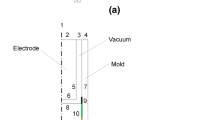Abstract
A new nonstationary three-dimensional mathematical model of an aluminum reduction cell which makes it possible to perform coupled thermoelectric and magneto-hydrodynamic calculation while taking into account sideledge formation is presented. The model takes into account the nonlinear dependence of the coefficients of electrical conductivity and thermal conductivity of materials on temperature, as well as, for ferromagnetic materials, the nonlinear dependence of magnetization on the magnetic field strength. The heat-transfer coefficients on the outer surfaces include radiant and convective components of heat transfer and are functions of the ambient temperature and the local surface temperature. In the energy equation, internal sources of heat are taken into account due to the flow of electric current, exothermic reactions, and additional thermal effects associated with the raw material loading and phase transitions. To obtain a numerical solution, the control volume method is applied. Experimental testing of the developed mathematical model is performed on the S8BME aluminum reduction cell. This paper presents the calculated and experimental data of magnetic, electric, thermal, and hydrodynamic fields. A comparison of the calculation results with the results of industrial experiments shows that the model reflects the physical processes taking place in the aluminum reduction cell with accuracy sufficient for engineering calculations. The calculated values of electrical voltage, magnetic induction, and temperature practically coincide with the measured ones. Values obtained from calculating the direction of velocity in the metal pad and the shape of the sideledge profile differ insignificantly from the experimental values. This model can be used to estimate the performance and design parameters of the operation of new and modernized aluminum electrolysis cells. Further studies will be aimed at clarifying the calculated results by improving the mathematical model.








Similar content being viewed by others
REFERENCES
Qiang Wang, Baokuan Li, and Fafad, M., Effect of anode change on heat transfer and magnetohydrodynamic flow in aluminum reduction cell, JOM, 2016, no. 68, pp. 610–622.
Yang Song, Jianping Peng, Yuezhong Di, Yaown Wang, and Naixiang Feng, Performance of the cathodes with trapezoidal protrusions in aluminum electrolysis cells, JOM, 2017, no. 69, pp. 2844–2850.
Meijia Sun, Baokuan Li, Linmin Li, and Jianping Peng, Effect of steel multi-collector bars on current density and magnetohydrodynamic stability in an aluminum reduction cell, Light Metals, 2018, pp. 565–572.
Bojarevics, V., Time dependent MHD models for aluminum reduction cells, Light Metals, 2010, pp. 199–206.
Hua, J., Rudshaug, M., Droste, C., Jorgensen, R., and Giskeodegard, N.-H., Modelling of metal flow and metal pad heaving in a realistic reference aluminum reduction cell, Light Metals, 2016, pp. 339–344.
Arkhipov, A., Alzarooni, A., Al Jasmi, A., and Potocnik, V., Improving the undestanding of busbar design and cell MHD performance, Light Metals, 2017, pp. 671–677.
Renaudier, S., Langlois, S., Bardet, B., Picasso, M., and Masserey, A., Alucell: a unique suite of models to optimize pot design and performance, Light Metals, 2018, pp. 541–549.
Bardet, B., Foetisch, T., Renaudier, S., Rappaz, J., Flueck, M., and Picasso, M., Alumina dissolution modelling in aluminium electrolysis cell considering MHD driven convection and thermal impact, Light Metals, 2016, pp. 315–319.
Hongliang Zhang, Ling Ran, Jinding Liang, Tianshuang Li, Kena Sun, and Jie Li, Study on 3D full cell ledge shape calculation and optimal design criteria by coupled thermos-flow model, Light Metals, 2018, pp. 587–596.
ANSYS CFX Release 18.2.0 Documentation, 2017.
Hirt, C.W. and Nichols, B.D., Volume of fluid (VOF) method for the dynamics of free boundaries, J. Comput. Phys., 1981, no. 39, pp. 201–225.
Brent, A.D., Voller, V.R., and Reid, K.J., Enthalpy-porosity technique for modeling convection-diffusion phase change: application to the melting of a pure metal, Num. Heat Transf., 1988, no. 13(3), pp. 297–318.
Arkhipov, G.V., Pingin, V.V., Tretyakov, Ya.A., and Polyakov, P.V., Simulation of cell thermoelectric field with consideration of electrochemical processes, Light Metals, 2007, pp. 327–331.
Nemchinova, N.V., Radionov, E.Yu., and Somov, V.V., Study of influence of working space shape on MHD-parameters of electrolyzer operation during aluminium production, Vestn. Irkut. Gos. Tekhn. Univ., 2019, vol. 23, no. 1, pp. 169–178.
Mintsis, M.Ya., Polyakov, P.V., and Sirazutdinov, G.A., Aluminum Electrometallurgy, Novosibirsk: Nauka, 2001.
Potocnik, V. and Laroche, F., Comparison of measured and calculated metal pad velocities for different prebake cell designs, Light Metals, 2001, pp. 419–425.
Stakhanov, V.V., Redkin, A.A., Zaikov, Y.P., and Galashev, A.E., Influence of electrolyte composition and overheating on the sideledge in the aluminum cell, Izv. Vyssh. Uchebn. Zaved., Tsvetn. Metall., 2018, no. 4, pp. 24–30.
Hongliang Zhang, Qiyu Wang, Jie Li, Hui Guo, Jingkun Wang, and Tianshuang Li, Study on side ledge behavior under current fluctuations based on coupled thermoelectric model, Light Metals, 2019, pp. 647–655.
Nandana, V., Gutt, R., Gesell, H., Cubeddu, A., Duessel, R., and Janoske, U., Virtual battery foam: a multi-physics numerical solver to simulate the aluminium electrolysis process, Proc. ICSOBA Conf., Belem, 2018, pp. 961–976.
Solheim, A., Giskeodegard, N.H., and Holt, N.J., Sideledge facing metal in aluminium electrolysis cells: freezing and melting in the presence of a bath film, Light Metals, 2016, pp. 333–338.
Solheim, A., Hjertenas, E., Tschope, K., Kucharik, M., and Holt, N.J., Sideledge in aluminium cells: further considerations concerning the trench at the metal-bath boundary, Light Metals, 2019, pp. 787–793.
Author information
Authors and Affiliations
Corresponding authors
Ethics declarations
The authors declare to have no conflict of interest.
Additional information
Translated by K. Gumerov
About this article
Cite this article
Pianykh, A.A., Arkhipov, G.V. & Tretyakov, Y.A. Mathematical Model of Magnetic Hydrodynamics and Heat Transfer in an Aluminum Reduction Cell. Russ. J. Non-ferrous Metals 61, 65–73 (2020). https://doi.org/10.3103/S1067821220010125
Received:
Revised:
Accepted:
Published:
Issue Date:
DOI: https://doi.org/10.3103/S1067821220010125




